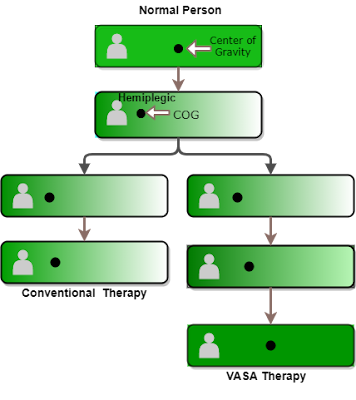Read these testimonials:
Pekka Hyysalo, a professional skier from Finland says,''In 2010, as I was filming a skiing session in Yllas, a sudden blast of wind caused me to overshoot. I landed unconscious after succumbing to several traumatic brain injuries. I lost my ability to move, speak, eat, couldn't attend to my daily needs with failing memory problems. In 2015, I started following VAASA. It is barely eight months now and the gains are unbelievable! My walking is much smoother without toppling. There is a huge improvement in my clawed toes, contractures, facial asymmetry and annoying skin sensations. It is really amazing to see small things like balls and ropes working which modern high tech machines failed to accomplish in my case.''
Naheed Ansari, who had to encounter a left hemiplegia owing to sudden brain haemorrhage (due to pre-eclampsia) before her delivery, writes from Mumbai, India,''Life seemed to have come to a void filled with negativity when there was no improvement in my paralytic condition after consulting many neurologists, physiotherapists, personal trainers and adopting many diet programs after spending a lot of money for over 3 years. The improvement started right after I started VASA exercises. Within a month, I was able to cross the road and travel with my son in a taxi, alone! Today, I can take 4 lectures at a stretch in my college without getting fatigued. I am a different person now, ready to face any challenge without fear.''
Larry McWhorter writes from the United States,''In May 2008, my wife Carole suffered a massive ischemic stroke and she became unresponsive. Part of her right skull bone needed to be cut out for decompression. She lost control of her left side and it was very painful for us to watch her in this helpless condition. Rehab started with a painfully slow recovery. She was told to accept her fate and stay within the confines of her disability. Desperate emotionally and economically, I searched elsewhere. I came to know about VASA through web discussion forums. We consulted Dr. Vasa, who lives in another part of the globe. When we started following the techniques she suggested, Carole showed signs of recovery right from the first day. Today she walks without dragging her feet or losing her balance. I am glad to report that she is steadily improving, although she still has a long way to travel."
Melanie Edmonds, another stroke patient, writes from Australia,''After trying countless methods from mystic healers to modern neurologists, I was convinced that what is lacking in the contemporary methods that are being offered in Australia is the confidence in their own treatment, their assurances are full of uncertainties. For 6 years I was looking for someone who could stand up, look into your eyes and say - You can recover 100%, yes I mean 100%. Not with promises, but with solid results. I found no one until I came across Dr. Vasa. The VASA method has been the only method that has worked for me in ways contemporary methods have not. It is based upon some logic and intelligence. It made sense. Within only 3 weeks I felt life coming back to my body, I am feeling once more the very person I once used to be."
Victoria Matthews shares her experience from the U.S.,''Various symptoms which started showing up after I had a stroke kept on worsening until I was at the end of my rope. I once landed on Dr. Vasa's website and liked her sensible approach. I emailed her. She agreed to help long distance. She asked for my videos and then sent me my first set of repetitive exercises. I even saw immediate results 10 years after my stroke! My typing ability improved, constant tightness in my thigh dissipated, my leg became less heavy, the great toe stayed relaxed, my limping has subsided, my right thigh no longer hurts...I am making great strides!"
Lalita Batra writes about her paralytic husband from India,''We lost count of how many physiotherapists, speech therapists and neurologists we had. They used to say that recovery would take time as time is the only medicine. After a period of a few months, they would say that it was too late! One day at a random time in a random place a complete stranger walked up to my husband and started asking questions about his illness. It was too difficult for us to believe that person when he said that he, himself was a paralytic a few years back and now he has completely recovered! He said if there was anybody who could help, it was only Dr. Vasa. Ever since my husband started following VASA treatment, he has been improving tremendously. Joints and muscles are coming back to their normal position, drooling of saliva has stopped, he sings now and surprises everyone. We are grateful to God for sending a fairy angel - Dr. Vasa, who is currently moving her magic wand to bring our old young Kishan back!"
While testimonials like these keep pouring in, Dr. Rajul Vasa's philanthropic work continues. She has been no less than a savior for patients who had lost control of their muscles due to various reasons - accidental or pathogenic. They are back on their way to their old healthy self again with great accomplishments week by week, month by month. These are the same patients who had lost hope on all grounds. Surprisingly, they also come from technically advanced countries like the U.S., U.K., Germany, Australia, Australia etc. One doesn't surprise when one reads about the resurrection of Christ as much as one does while reading the revival of such patients, we can say partially-brain-dead patients.
DR. RAJUL VASA
Dr. Rajul Vasa belongs to that rare creed of doctors who have got both – A Head as well as a Heart. She is a Neuro-physiotherapist who graduated in India and had her post-graduation completed in Switzerland. When she started working with her patients, she used to imagine herself sitting in a patient's chair. A patient who is dependent, desperate and depressed when traditional physiotherapy tells  him at the end of the treatment that this is the end of the road for him towards recovery and beyond a certain point he won't progress. He is left to negotiate his fate and adapt to the compromised state of health for the rest of his life. Leaving the patient and his family floundering in the maze of uncertainty was certainly not the reason Dr. Vasa had chosen a career as a specialized physiotherapist in Neurology. She wondered how the worldwide established techniques are themselves paralyzed as far as post-stroke rehabilitation of the patients was concerned, as most of them remain in a vegetative state. Her frustration led to curiosity which led to further determination to explore new ways to tackle various sensory-motor problems in her field. The search spurred to carry out a lot of experiments, observations and question-answers with her paralytic patients who were equally eager to cooperate with her. Out of the amalgamation of diverse experimental evidences, took shape a purely logical and result-oriented therapy – The VASA Concept. Dr. Rajul says,''Self-organized brain is mightier than any therapeutic technique in the world unless it is approached with the same language that it speaks!''
him at the end of the treatment that this is the end of the road for him towards recovery and beyond a certain point he won't progress. He is left to negotiate his fate and adapt to the compromised state of health for the rest of his life. Leaving the patient and his family floundering in the maze of uncertainty was certainly not the reason Dr. Vasa had chosen a career as a specialized physiotherapist in Neurology. She wondered how the worldwide established techniques are themselves paralyzed as far as post-stroke rehabilitation of the patients was concerned, as most of them remain in a vegetative state. Her frustration led to curiosity which led to further determination to explore new ways to tackle various sensory-motor problems in her field. The search spurred to carry out a lot of experiments, observations and question-answers with her paralytic patients who were equally eager to cooperate with her. Out of the amalgamation of diverse experimental evidences, took shape a purely logical and result-oriented therapy – The VASA Concept. Dr. Rajul says,''Self-organized brain is mightier than any therapeutic technique in the world unless it is approached with the same language that it speaks!''
As of today, Dr. Rajul is running three rehabilitation centers: In Mumbai, Nasik (both in India) and in Turki, Finland. Patients are treated FREE of charge irrespective of any caste, creed, religion or nationality!
Where Does Conventional Physiotherapy Go Wrong?
The Revolutionary VASA Concept
Offering a new cornerstone for stroke rehabilitation, VASA Concept is a whole new way of radical thinking. Although a paradigm shift in the contemporary ways, it is extremely simple and logical. It says that appearance of abnormal movements, spasticity, rigidity, paraesthesia etc. means the brain is being conditioned in an abnormal or improper way.
According to VASA concept, it is never too late for recovery. The human brain has got amazing powers of re-organizing, retraining and recuperating, no matter how old your disability is. The motive of the human brain is to function optimally, always. In a neuromuscular element, it is evident by the maintenance of normal tone in the muscle, neither spasticity nor over-reflexiveness. In a paretic muscle, proprioception is lost. In VASA rehabilitation technique, it is attempted to be reestablished by appealing to cortical senses like vision, touch and vestibular perception. The lost bridge between the brain and various objects in the surrounding area is reconstructed using a rigorous muscle training program.
Wait, there is one more golden principle under the belt of VASA concept. Absence of money will never be a factor which will deprive the patient of this treatment! This is the reason, Rajul Vasa Foundation has a persistent paucity of funds and they are unable to open new centers.
OUTCOMES OF VASA TREATMENT
• Reduction in tightness and soreness of muscles
• Correction of abnormal posture and regaining of balance
• Correction of foot-drop and restoration of normal foot curvature
• Control of involuntary spasms in case of spinal cord injury
• Improvement in bowel and bladder control
• In chronic patients, improvement in muscle tone and reduction in flaccidity or looseness
• Correction of tilting/drooping in shoulder and/or pelvic girdle
• Improvement in writing, typing, finger gripping
• Correction of facial asymmetry
• Restoration of communicative, perceptual, interactive and cognitive (comprehension) abilities
• Patient becomes self-reliant, independent and confident
Here, you can see various exercise videos
Here, you can contact Rajul Vasa Foundation.




















































This is really interesting. I intend to suggest this to my neighbor who is down with some form of paralysis and I will contact you asap.
ReplyDeleteI could remember a few months ago when a friend of mine developed paralysis. We tried all we could to cure him all to no avail. However, someone introduced the Vasa treatment to him. And today he works with his two legs all smiles.
ReplyDeleteThis is really awesome article. A very descriptive information on VASA concept. thanks for writing such beautiful and useful post:y. it will help thousands. i will suggest this treatment to my friend who is suffering from paralysis.
ReplyDeleteReally amazed to know about Dr. VASA’s treatment methodology and the results patients get from her treatment…😮. Salute to her amazing process!! Recommendable, really!!👩⚕️
ReplyDeleteAs someone with a close friend going through the conventional treatment, I can say it has not been good. I have said for many years now that the modern and "acceptable" medicine practices of the world have got it wrong. You have to work with the body to heal, not separate from it with drugs to try to cover up the problem. I am going to share this with her right now!
ReplyDelete